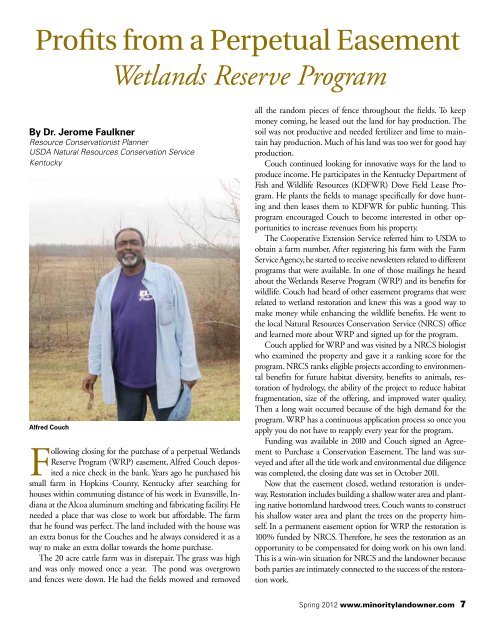Spring 2012 - Minority Landowner
Spring 2012 - Minority Landowner
Spring 2012 - Minority Landowner
You also want an ePaper? Increase the reach of your titles
YUMPU automatically turns print PDFs into web optimized ePapers that Google loves.
Profits from a Perpetual Easement<br />
By Dr. Jerome Faulkner<br />
Resource Conservationist Planner<br />
USDA Natural Resources Conservation Service<br />
Kentucky<br />
Alfred Couch<br />
Wetlands Reserve Program<br />
Following closing for the purchase of a perpetual Wetlands<br />
Reserve Program (WRP) easement, Alfred Couch deposited<br />
a nice check in the bank. Years ago he purchased his<br />
small farm in Hopkins County, Kentucky after searching for<br />
houses within commuting distance of his work in Evansville, Indiana<br />
at the Alcoa aluminum smelting and fabricating facility. He<br />
needed a place that was close to work but affordable. The farm<br />
that he found was perfect. The land included with the house was<br />
an extra bonus for the Couches and he always considered it as a<br />
way to make an extra dollar towards the home purchase.<br />
The 20 acre cattle farm was in disrepair. The grass was high<br />
and was only mowed once a year. The pond was overgrown<br />
and fences were down. He had the fields mowed and removed<br />
all the random pieces of fence throughout the fields. To keep<br />
money coming, he leased out the land for hay production. The<br />
soil was not productive and needed fertilizer and lime to maintain<br />
hay production. Much of his land was too wet for good hay<br />
production.<br />
Couch continued looking for innovative ways for the land to<br />
produce income. He participates in the Kentucky Department of<br />
Fish and Wildlife Resources (KDFWR) Dove Field Lease Program.<br />
He plants the fields to manage specifically for dove hunting<br />
and then leases them to KDFWR for public hunting. This<br />
program encouraged Couch to become interested in other opportunities<br />
to increase revenues from his property.<br />
The Cooperative Extension Service referred him to USDA to<br />
obtain a farm number. After registering his farm with the Farm<br />
Service Agency, he started to receive newsletters related to different<br />
programs that were available. In one of those mailings he heard<br />
about the Wetlands Reserve Program (WRP) and its benefits for<br />
wildlife. Couch had heard of other easement programs that were<br />
related to wetland restoration and knew this was a good way to<br />
make money while enhancing the wildlife benefits. He went to<br />
the local Natural Resources Conservation Service (NRCS) office<br />
and learned more about WRP and signed up for the program.<br />
Couch applied for WRP and was visited by a NRCS biologist<br />
who examined the property and gave it a ranking score for the<br />
program. NRCS ranks eligible projects according to environmental<br />
benefits for future habitat diversity, benefits to animals, restoration<br />
of hydrology, the ability of the project to reduce habitat<br />
fragmentation, size of the offering, and improved water quality.<br />
Then a long wait occurred because of the high demand for the<br />
program. WRP has a continuous application process so once you<br />
apply you do not have to reapply every year for the program.<br />
Funding was available in 2010 and Couch signed an Agreement<br />
to Purchase a Conservation Easement. The land was surveyed<br />
and after all the title work and environmental due diligence<br />
was completed, the closing date was set in October 2011.<br />
Now that the easement closed, wetland restoration is underway.<br />
Restoration includes building a shallow water area and planting<br />
native bottomland hardwood trees. Couch wants to construct<br />
his shallow water area and plant the trees on the property himself.<br />
In a permanent easement option for WRP the restoration is<br />
100% funded by NRCS. Therefore, he sees the restoration as an<br />
opportunity to be compensated for doing work on his own land.<br />
This is a win-win situation for NRCS and the landowner because<br />
both parties are intimately connected to the success of the restoration<br />
work.<br />
<strong>Spring</strong> <strong>2012</strong> www.minoritylandowner.com 7


